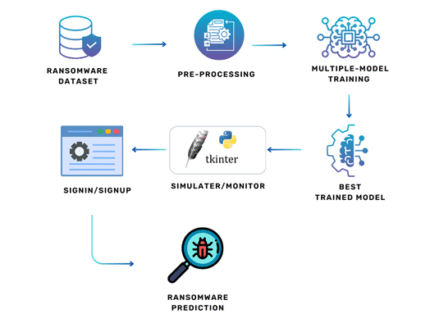Aim:
To develop a robust machine learning system for detecting money laundering activities in blockchain transactions using Random Forest, Decision Tree, LightGBM, and CatBoost models.
Abstract:
Money laundering through cryptocurrency transactions represents one of the most sophisticated financial crimes due to the anonymity, decentralization, and layering techniques employed within blockchain systems. Traditional monitoring mechanisms fail to achieve high accuracy. This study introduces a novel machine-learning-based framework that leverages Random Forest, Decision Tree, LightGBM, and CatBoost models for detecting illicit transactions. Experimental results using real-world datasets demonstrate improved classification accuracy across legal and illegal transactions, highlighting the potential of the proposed system to support compliance and cybercrime prevention.
Introduction:
Blockchain technology has rapidly evolved as a decentralized and secure platform for digital transactions, offering transparency, immutability, and efficiency across industries. However, its pseudonymous nature has simultaneously opened doors for illicit financial activities, particularly money laundering, where criminals exploit blockchain networks to conceal and transfer illegal funds. Traditional financial monitoring systems, designed for centralized institutions, often struggle to address the complexities of blockchain-based ecosystems. In this context, machine learning (ML) has emerged as a powerful tool to analyze large-scale blockchain data, uncover hidden patterns, and detect anomalous or suspicious transactions. By leveraging techniques such as supervised learning, unsupervised clustering, and ensemble modeling, ML-based frameworks enhance the accuracy and reliability of anti-money laundering systems.
Proposed System:
The proposed system applies Random Forest, Decision Tree, LightGBM, and CatBoost models to detect money laundering in blockchain transactions. The Decision Tree provides a simple and interpretable baseline, while Random Forest improves robustness and reduces overfitting. LightGBM ensures fast and scalable performance for large datasets, and CatBoost enhances accuracy by effectively handling categorical features. Together, these models classify transactions into legal and illegal ensuring robust and reliable detection across diverse blockchain data.
Advantage:
High detection accuracy, scalability for large blockchain datasets, reduced overfitting, efficient handling of categorical features, and improved reliability for compliance investigations.





















Reviews
There are no reviews yet.